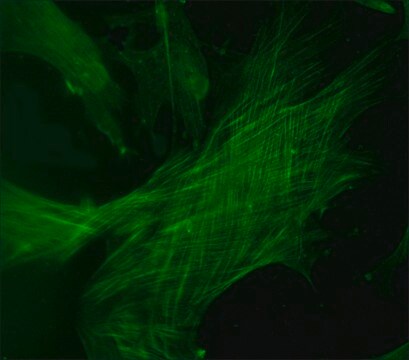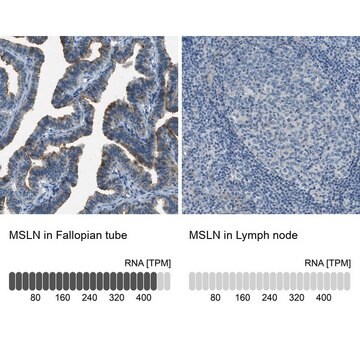MABT1335
Anti-Tropomyosin 3 Antibody, clone 2G10.2
Synonim(y):
Gamma-tropomyosin, Tropomyosin-3, Tropomyosin-5, TPM3, Tm3
About This Item
Polecane produkty
pochodzenie biologiczne
mouse
forma przeciwciała
purified antibody
rodzaj przeciwciała
primary antibodies
klon
2G10.2, monoclonal
masa cząsteczkowa
~30 kDa (Uncharacterized bands may be observed in some lysates.)
oczyszczone przez
using protein G
reaktywność gatunkowa
human, mouse, rat
metody
immunofluorescence: suitable
western blot: suitable
izotyp
IgG2bκ
numer dostępu NCBI
numer dostępu UniProt
informacje o genach
mouse ... TPM3(117557)
Opis ogólny
Specyficzność
Immunogen
Zastosowanie
Immunofluorescence Analysis: A representative lot detected Tropomyosin 3 in Immunofluorescence applications (Schevzov, G., et. al. (2011). Bioarchitecture. 1(4):135-164).
Western Blotting Analysis: A representative lot detected Tropomyosin 3 in Western Blotting applications (Schevzov, G., et. al. (2011). Bioarchitecture. 1(4):135-164).
Jakość
Postać fizyczna
Przechowywanie i stabilność
Inne uwagi
Oświadczenie o zrzeczeniu się odpowiedzialności
Nie możesz znaleźć właściwego produktu?
Wypróbuj nasz Narzędzie selektora produktów.
Certyfikaty analizy (CoA)
Poszukaj Certyfikaty analizy (CoA), wpisując numer partii/serii produktów. Numery serii i partii można znaleźć na etykiecie produktu po słowach „seria” lub „partia”.
Masz już ten produkt?
Dokumenty związane z niedawno zakupionymi produktami zostały zamieszczone w Bibliotece dokumentów.
Nasz zespół naukowców ma doświadczenie we wszystkich obszarach badań, w tym w naukach przyrodniczych, materiałoznawstwie, syntezie chemicznej, chromatografii, analityce i wielu innych dziedzinach.
Skontaktuj się z zespołem ds. pomocy technicznej








